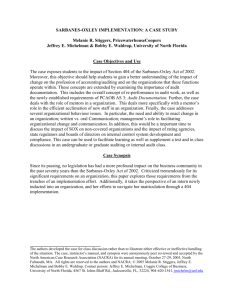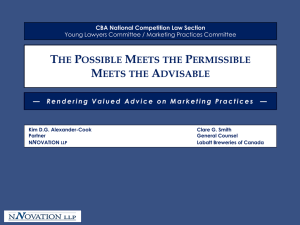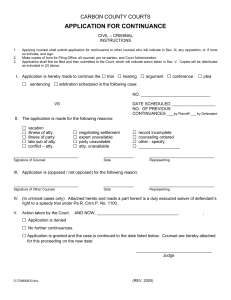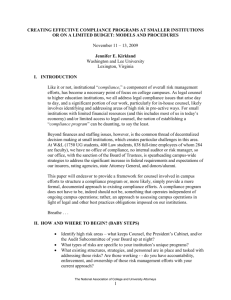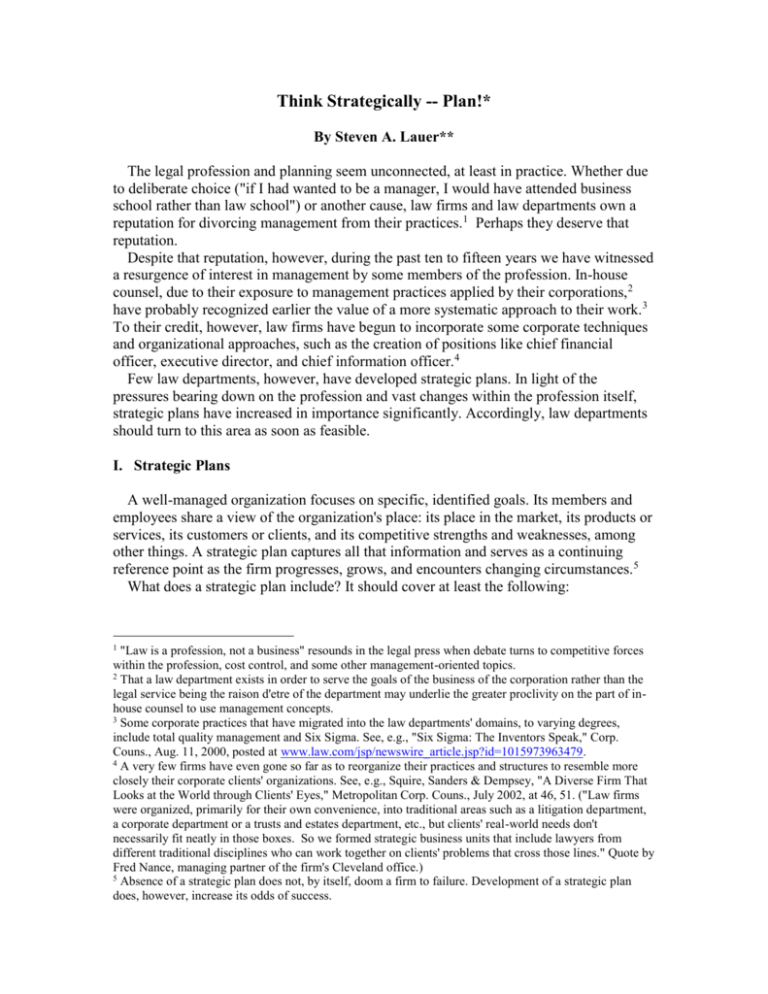
Think Strategically -- Plan!*
By Steven A. Lauer**
The legal profession and planning seem unconnected, at least in practice. Whether due
to deliberate choice ("if I had wanted to be a manager, I would have attended business
school rather than law school") or another cause, law firms and law departments own a
reputation for divorcing management from their practices.1 Perhaps they deserve that
reputation.
Despite that reputation, however, during the past ten to fifteen years we have witnessed
a resurgence of interest in management by some members of the profession. In-house
counsel, due to their exposure to management practices applied by their corporations,2
have probably recognized earlier the value of a more systematic approach to their work.3
To their credit, however, law firms have begun to incorporate some corporate techniques
and organizational approaches, such as the creation of positions like chief financial
officer, executive director, and chief information officer.4
Few law departments, however, have developed strategic plans. In light of the
pressures bearing down on the profession and vast changes within the profession itself,
strategic plans have increased in importance significantly. Accordingly, law departments
should turn to this area as soon as feasible.
I. Strategic Plans
A well-managed organization focuses on specific, identified goals. Its members and
employees share a view of the organization's place: its place in the market, its products or
services, its customers or clients, and its competitive strengths and weaknesses, among
other things. A strategic plan captures all that information and serves as a continuing
reference point as the firm progresses, grows, and encounters changing circumstances. 5
What does a strategic plan include? It should cover at least the following:
1
"Law is a profession, not a business" resounds in the legal press when debate turns to competitive forces
within the profession, cost control, and some other management-oriented topics.
2
That a law department exists in order to serve the goals of the business of the corporation rather than the
legal service being the raison d'etre of the department may underlie the greater proclivity on the part of inhouse counsel to use management concepts.
3
Some corporate practices that have migrated into the law departments' domains, to varying degrees,
include total quality management and Six Sigma. See, e.g., "Six Sigma: The Inventors Speak," Corp.
Couns., Aug. 11, 2000, posted at www.law.com/jsp/newswire_article.jsp?id=1015973963479.
4
A very few firms have even gone so far as to reorganize their practices and structures to resemble more
closely their corporate clients' organizations. See, e.g., Squire, Sanders & Dempsey, "A Diverse Firm That
Looks at the World through Clients' Eyes," Metropolitan Corp. Couns., July 2002, at 46, 51. ("Law firms
were organized, primarily for their own convenience, into traditional areas such as a litigation department,
a corporate department or a trusts and estates department, etc., but clients' real-world needs don't
necessarily fit neatly in those boxes. So we formed strategic business units that include lawyers from
different traditional disciplines who can work together on clients' problems that cross those lines." Quote by
Fred Nance, managing partner of the firm's Cleveland office.)
5
Absence of a strategic plan does not, by itself, doom a firm to failure. Development of a strategic plan
does, however, increase its odds of success.
Vision. A "snapshot" of what members of the organization anticipate that it will
look like in two to three years.
Mission. A statement of the purpose of the business.
Objectives. Identified results that the organization hopes to achieve, which should
be aligned with the needs of its various stakeholders.
Values. The ethical rules or standards of behavior by which the organization
operates in its relationships with others.
Strategies. Guidelines by which the organization expects to achieve its mission.
Goals. Specific, short-term, measurable steps toward the objectives.
Programs. Plans by which the organization intends to implement its strategies.
These plans will cover subjects such as resources, products, services, finances,
and utilization, among others.
The strategic plan should include visionary, conceptual, and directional elements. In
order to set future direction, which is a primary purpose of a strategic plan, one must
thoroughly understand where an organization has been and its present status. Thus, the
process of developing a strategic plan should include an assessment of the organization's
history and current situation.
II. Why Now?
While a strategic plan serves very valuable purposes at any time, it assumes particular
importance at a time of great flux in the environment in which an organization operates
or at a time of pressure on an organization. At such times, a strategic plan can enable the
organization to hew to its plans and objectives despite the buffeting that it endures.
Corporate law departments are experiencing such buffeting at present unlike any time
they have seen before.
Enactment of the Sarbanes-Oxley Act of 2002 (Sarbanes-Oxley) constitutes a dramatic
marker for the abrupt transformation of the environment in which law departments exist.
Intense, unrelenting scrutiny now characterizes that environment. While that statute alone
could serve as a bellwether event, other forces, at the same time, accentuate the changes
that corporate law departments must navigate.
For example, the demise of Enron Corporation has been blamed, at least in part, on its
lawyers, both in-house and outside, for their parts in enabling the commission of
significant frauds at that company by many of its senior managers.6 Also, the former
general counsel at Tyco was indicted for his role in some of the misdeeds at that
corporation.7
As a result of these and other events, in-house counsel are under scrutiny like never
before and subject to pressures unlike any they previously experienced.
6
See Koniak, "Who Gave Lawyers a Pass?" Forbes, Aug. 1, 2002, at 69.
See Lin, "Former Tyco GC Indicted on New Felony Charges," N.Y. L.J., Feb. 3, 2003, appearing at
www.law.com/jsp/newswire_article.jsp?id=1044059415351.
7
[T]he post-Enron corporate governance crusade has thrust audit committees into
the spotlight, at the same time charging them with a glut of new regulations. For
wary in-house counsel, it's like learning to play piano on stage at Carnegie Hall.
General counsel must assimilate the complex and often unclear requirements
under Sarbanes-Oxley, as well as new SEC and exchange rules. They must advise
boards and committees that are being radically reshaped by these regulations, and
at the same time reevaluate their own role on the committee, which was strange to
begin with. All of this is taking place under the harsh glare of shareholder and
federal scrutiny.8
With all those stresses hitting the legal function of a corporation, a better-defined road
map of the responsibilities of that function, and how those responsibilities relate to the
company's business operations and the various business units that effect those operations,
is of greater importance. "To navigate changing regulatory, professional and marketplace
patterns and get maximum growth with minimum waste, [an organization] needs a recipe
for action -- that is, a strategic plan."9
III. Some Areas of Focus in a Strategic Plan
On what areas should a strategic plan for a law department focus? A quick review of
Sarbanes-Oxley and the associated actions of the SEC suggests some areas. While other
areas may deserve such treatment as well, these illustrate the purpose and potential
benefits to a law department of a strategic plan.10
A. Organizational Structure and Reporting Relationships
To whom should a company's chief legal officer report? Only to the CEO? To another
officer? Prior to enactment of Sarbanes-Oxley, the reporting relationships of the chief
legal officer position represented internal organizational choices. Factors such as
corporate style and the predilections of individual corporate officers might have impacted
that decision.
Sarbanes-Oxley introduced other issues. The statute imposes certain reporting
relationships even where they do not otherwise exist. For example, it requires that an
attorney for an issuer report to the company's audit committee if that attorney has
previously informed the company's chief legal officer of "evidence of a material violation
of securities law or a breach of fiduciary duty" and that chief legal officer has failed to
8
Andersen, "High Anxiety," Corp. Legal Times, Feb. 2003, at 1, 38.
Purcell, "Strategic Planners Lead the Pack," J. Acct., Dec. 2001, at 26. That law departments face
"changing regulatory, professional and marketplace patterns" is beyond argument. See Deligiannis,
"Counsel Matters Take Center Stage at Chicago Conference," Corp. Legal Times, Mar. 2003, at 8 ("[T]he
passage of the Sarbanes-Oxley Act of 2002, as well as new NYSE and NASDAQ rules, have heightened
the general counsel's sense of responsibility and, in some ways, anxiety. Now, more than ever, the role of
the general counsel is evolving.").
10
I don't mean to imply that Sarbanes-Oxley and SEC rules are the sole bases for developing a strategic
plan or the only measures for what a plan should address. I identify issues here merely to illustrate some
possible focus of a plan.
9
"appropriately respond to the evidence."11 The SEC's final rules on standards of
professional conduct for attorneys (the Final Rules), which it issued pursuant to § 307 of
Sarbanes-Oxley, contain considerable, additional detail regarding that professional
obligation. They provide that a company can create a "qualified legal compliance
committee" and that the creation of such a committee changes the obligation of an
attorney in that situation.12 The Final Rules do not address explicitly, however, the
relationship between the general counsel or the law department, on the one hand, and the
board of directors or qualified legal compliance committee, on the other.
The requirement in various places of the Final Rules that issues be reported to both the
CEO and the chief legal officer13 raises the question of whether the general counsel
should report only to the CEO rather than another officer. The statute and the Final Rules
do not mandate such a reporting relationship, but the various provisions certainly provide
ample support for that view.
Regardless of what specific reporting relationships one selects after due deliberation, it
would be wise to memorialize them in a strategic plan. In that way, all officers and
employees of the company, as well as its outside counsel, regulators, and other interested
parties, will have a single source of guidance on that question.
B. Compliance and Internal Controls
Sarbanes-Oxley focuses to a great extent on the existence and operation of
corporations' internal controls. Internal controls relate to the compliance regime and they
serve, to a large degree, to assure that a company's accounting mechanisms properly
capture and account for that company's liabilities, potential liabilities, and other attributes
that can impact its valuation and viability. The subject of internal controls, however,
presents to in-house lawyers many issues with which they are not familiar.
Board members now demand continuous updates on the changing regulatory
climate, as well as the design of compliance mechanisms such as certification
programs, disclosure controls and codes of conduct. Committees clamor for
advice on new requirements. They all want to know what Sarbanes-Oxley means,
and how the company will tailor its response.14
The Committee of Sponsoring Organizations (COSO) of the Treadway Commission15
defines internal control as "a process, effected by an entity's board of directors,
11
Section 307(2) of Sarbanes-Oxley.
See Final Rules § 205.3(c), posted at www.sec.gov/rules/final/33-8185.htm. This provision obviates the
obligation of an attorney to follow the up-the-ladder reporting sequence set out in Final Rules § 205.3(b).
13
See, e.g., Final Rules §§ 205.2(k)(3)(i) and 205.3(b)(1).
14
Andersen, "What Now? Uncertainty, Transition and the Role of the General Counsel," Corp. Legal
Times, Apr. 2003, at 1, 47.
15
This organization describes itself as "a voluntary private sector organization dedicated to improving the
quality of financial reporting through business ethics, effective internal controls, and corporate governance.
COSO was originally formed in 1985 to sponsor the National Commission on Fraudulent Financial
Reporting, an independent private sector initiative which studied the causal factors that can lead to
fraudulent financial reporting and developed recommendations for public companies and their independent
auditors, for the SEC and other regulators, and for educational institutions." See www.coso.org.
12
management, and other personnel, designed to provide reasonable assurance regarding
the achievement of objectives in the following categories:
o effectiveness and efficiency of operations;
o reliability of financial reporting; and
o compliance with applicable laws and regulations."16
The relationship between the mission of a law department and the company's internal
control structure is clear, at least in respect of the last point. How the law department
coordinates its activity with the rest of the internal control activities is, of course, not
clear from that definition. A strategic plan can describe that coordination.
Compliance, which is closely related to internal control concepts, "describes the ability
to act according to an order, set of rules, or request."17 What is the relationship of a
company's legal function, whether constituted as a law department, an office of general
counsel or some other entity, and the company's compliance operation? Do the
employees who are engaged in the compliance efforts report to the chief legal officer? Do
they report to another executive (usually denominated the chief compliance officer or an
equivalent title)? What role do the company's in-house attorneys play in the compliance
regimen?
By setting out in a strategic plan how the legal function is expected to participate in its
compliance and internal control efforts, a company can reduce the possibility that
confusion will undermine the effectiveness of those efforts. Moreover, by requiring that
senior management detail its understanding of what the compliance effort entails, the
plan will conduce toward a more complete compliance protocol and a more
comprehensive approach to the subject.
C. Records Management
The demise of Arthur Andersen as a result of its conviction for obstruction of justice
for having destroyed records relating to its work for Enron Corporation18 has reinforced
the importance of good records management policies and, perhaps more importantly,
their effective operation.19 A good policy covers a wide range of issues, including
definition of records, storage of records, appropriate records-destruction schedules, and
responding to discovery demands and judicial process vis-à-vis records retention.20
What role does the law department play in the development of a company's records
management policy? Do the in-house lawyers participate in its ongoing operation? If so,
in what fashion? These and other issues relate to the department's organizational role and
16
Id.
See International Compliance Association, "Compliance & the Regulatory Environment FAQ" at
www.intcomp.org/doc.asp?docId=6920&CAT_ID=676.
18
See Jeffreys, "Andersen Gets Maximum Sentence for Obstruction of Justice," Tex. Law., Oct. 17, 2002,
appearing at www.law.com/jsp/newswire_article.jsp?id=1032128761960.
19
See footnote 12 and accompanying text in Cohen & Lender, "Retaining Documents in the Electronic
Age," N.Y. L.J., Jan. 3, 2003, appearing at www.law.com/jsp/newswire_article.jsp?id=1039054481250.
20
See Dietel, "The Importance of Effective Information and Records Management -- Part I," Metropolitan
Corp. Couns., Oct. 2001, at 46; see also Dietel, "The Importance of Effective Information and Records
Management -- Part II," Metropolitan Corp. Couns., Dec. 2001, at 30.
17
responsibilities. For that reason, they constitute appropriate subjects for treatment in the
department's strategic plan.
D. Audit Committee Responsibilities
Section 301 of Sarbanes-Oxley added a new § 10A(iii)(4) to the Securities Exchange
Act of 1934. That new law imposes a new duty on the audit committee of a publicly held
corporation.
Each audit committee shall establish procedures for (A) the receipt, retention, and
treatment of complaints received by the [corporation] regarding accounting,
internal accounting controls, or auditing matters; and (B) the confidential,
anonymous submission by employees of the [corporation] of concerns regarding
questionable accounting or auditing matters.21
One commentator described this requirement of that statute as "a powder keg whose fuse
Congress lit."22 That same commentator advised that, while the mandate applied to audit
committees, in-house counsel should "play a critical role in the development of the
compliance system."23
But what role should law departments play in that regard? What responsibilities should
they shoulder? How should the in-house attorneys relate to the audit committee in
satisfying that provision of the statute? How should they relate to those employees who
implement the mandate once the audit committee maps out the means of compliance?
These subjects fall within the appropriate scope of a strategic plan.
E. Supervisory versus Subordinate
The Final Rules distinguish between a "supervisory attorney" and a "subordinate
attorney." Those designations carry disparate responsibilities in respect of "up-the-ladder"
reporting under the Final Rules and Sarbanes-Oxley.24 To the extent that it can and
wishes to do so, a law department might wish to minimize the number of in-house
attorneys subject to the burdens associated with being "supervisory attorneys." By
delineating in a strategic plan which of the in-house attorneys supervise the company's
compliance with securities laws and the reporting relationships among those attorneys,
the general counsel, and the other in-house attorneys, the law department may be able to
minimize the impact of Sarbanes-Oxley (at least in respect of issues covered by the Final
Rules) on the day-to-day operation of the department.
21
Section 301 of Sarbanes-Oxley.
Liggio, "Sarbanes-Oxley Audit Committee Obligations -- A Hidden Time Bomb,"
Metropolitan Corp. Couns., Jan. 2003, at 34. One reason for so describing it was the short deadline for
compliance by audit committees of publicly held companies; compliance was required by April 27, 2003,
and the penalty for failure to comply, delisting.
23
Ibid.
24
Compare § 205.4 and § 205.5 of the Final Rules.
22
F. Appearing and Practicing
Related to the distinction between supervisory attorneys and subordinate attorneys, the
Final Rules set out a detailed definition of "appearing and practicing" before the SEC.
When it released the Final Rules, the SEC acknowledged "concerns regarding the
potential application of the rule to attorneys who, while admitted to practice in a state or
other United States jurisdiction, were not providing legal services to an issuer."25 As the
SEC explained, "[u]nder the final rule, attorneys need not serve in the legal department to
be covered by the final rule, but they must be providing legal services to an issuer within
the context of an attorney-client relationship."26 Particularly since the Final Rules
purport to override inconsistent standards of conduct in state bar ethics codes and permit
enforcement by the SEC of the Final Rules' mandates, a law department might want to
minimize the number of in-house attorneys who "appear and practice" before the SEC.
By delineating within a strategic plan which attorneys represent the company, in the
sense of having an attorney/client relationship, the department might insulate employees
elsewhere who, while admitted to practice law, have nonlegal responsibilities as
employees.
IV. Summary
A law department should consider developing and implementing a strategic plan, if it
has not done so already. In light of the considerable pressures now facing in-house law
departments and the changing environment in which they operate, clarity regarding the
department's organization place and role will serve the in-house lawyers, their corporate
employers, and other corporate employees well.
* Copyright 2005, Steven A. Lauer. All rights reserved. This article originally appeared in CORPORATE
COUNSEL'S QUARTERLY, which is published by Business Laws, Inc., 11630 Chillicothe Road,
Chesterland, Ohio, 44026, (440) 729-7996.
** Steven A. Lauer is Director, Integrity Research, Integrity Interactive Corporation, Matthews, North
Carolina, and he now consults with corporations regarding ethics- and compliance-related issues.. He spent
thirteen-and-one-half years as an in-house counsel for four organizations, including one of the largest law
departments in the country. He was responsible for litigation management for several business units and
associated issues, including counsel selection and management. He was project director for the effort of
the Law Department of The Prudential Insurance Company of America to use requests for proposals in its
counsel selection process. As a result of that effort, approximately 60 percent of the company's outside
legal service was awarded to eighty law firms. He later spent over two years as Executive Vice President,
Deputy Editor, and Publisher of The Metropolitan Corporate Counsel, a monthly journal for in-house
counsel. His telephone number is (704) 847-6430 and he can be reached by e-mail at slauer@i2c.com.
25
26
See www.sec.gov/rules/final/33-8185.htm.
Ibid.




